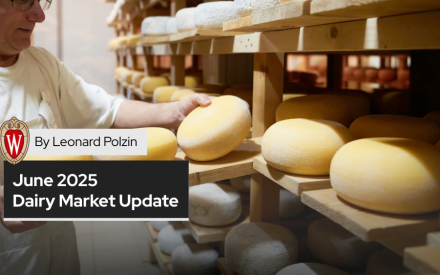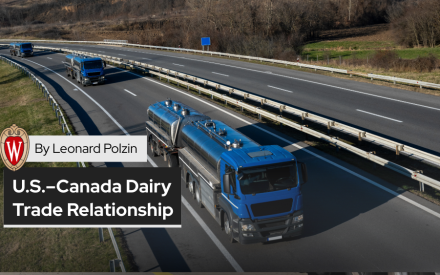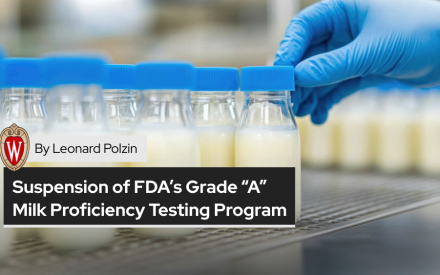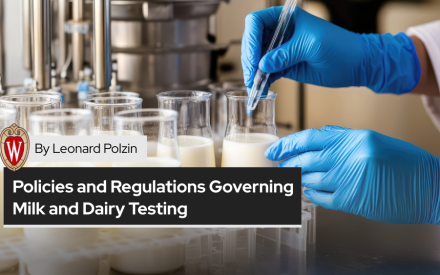Table of Contents

Introduction
This factsheet summarizes the full agricultural contribution report of Dr. Steven Deller, Community Economic Development Specialist within the UW-Madison, Division of Extension. The report focuses on agricultural sectors highlighting their contributions to employment, industrial revenues, and environmental impacts.
Key Contributions of Agriculture to the Wisconsin Economy (2022)
| Category | Industrial Revenue (Billion $) | Employment (Jobs) | Labor Income (Billion $) | Total Income (Billion $) |
|---|---|---|---|---|
| Total Agriculture (On-farm + Processing) | 116.3 | 353,900 | 21.2 | 37.8 |
| On-farm | 30.5 | 143,690 | 6.4 | 13.7 |
| Food Processing | 107.0 | 298,400 | 18.7 | 32.4 |
| Dairy (On-farm + Processing) | 52.8 | 120,700 | 7.9 | 13.7 |
Highlights:
- Total economic impact: $116.3 billion (14.3% of Wisconsin’s total industrial revenue).
- Employment: Agriculture supported 353,900 jobs (9.5% of the state’s total employment).
- Labor income: Agriculture generated $21.2 billion in labor income, with $37.8 billion in total income.
- Dairy industry: A significant contributor to the state’s economy, providing $52.8 billion in industrial revenue and 120,700 jobs.
Environmental Impact of Agriculture in Wisconsin (2022)
| Metric | Total Emissions | Percentage of State Emissions (%) |
|---|---|---|
| Greenhouse Gas Emissions (MMTCO2eq) | 17 | 14% |
| Dairy GHG Contribution (MMTCO2eq) | 7 | N/A |
Highlights:
- Greenhouse Gas Emissions: Agriculture in Wisconsin contributed 17 million metric tons of CO2 equivalent (14% of the state total).
- Dairy sector: Contributed 7MM TCO2eq of total agricultural emissions.
Regional Contributions of Agriculture to Wisconsin’s Economy (2022)
| Region | Agriculture Contribution to Total Industrial Revenue (%) | Dairy Contribution to Total Economic Activity (%) |
|---|---|---|
| North Central | 22.6% | N/A |
| Southwest | 27.4% | 18.1% |
| East Central | 15.7% | 8.1% |
Highlights:
- Southwest Wisconsin: Most dependent on agriculture, with 27.4% of total regional industrial revenue from agricultural activities, and 18.1% from dairy.
- East Central region: Largest regional contributor to Wisconsin’s dairy economy, with $13.3 billion in economic activity, representing 8.1% of total activity.
Sectors with Strongest Growth
- Dairy Processing (Cheese Production):
- Dominated Wisconsin’s food processing sector, accounting for nearly one-third (31.8%) of all food processing employment.
- Wisconsin produced 25% of all U.S. cheese in 2022.
- Frozen Food Manufacturing:
- A growing sector complementing the decline in traditional vegetable canning.
- Distilleries and Wineries:
- Both sectors experienced marked growth, with wineries increasing by 0.32 in the location quotient between 2001 and 2022.
- Support Activities for Animal Production:
- Contributed significantly to on-farm employment, particularly in services like artificial insemination and livestock breeding.
Sectors with Largest Employment Declines
- Dairy Industry (On-farm and Processing):
- Employment dropped by 23.2% between 2017 and 2022, due to consolidation and mechanization.
- Overall Agricultural Employment:
- Total agricultural employment declined by 19.1%, from 437,700 jobs in 2017 to 353,900 jobs in 2022.
- Beef Cattle Farming:
- Employment significantly declined, with its location quotient dropping from 2.33 in 2001 to 0.58 in 2022.
- Animal Slaughtering and Processing:
- Modest decline linked to restructuring within the sector.
Conclusion
Wisconsin agriculture remains a critical component of the state’s economy, with food processing—especially dairy—leading in industrial revenue and employment. Although agricultural employment has declined, value-added processes, such as cheese production and food processing, have seen notable growth. The state’s agricultural economy also faces environmental challenges, particularly in terms of greenhouse gas emissions. However, the diversified agricultural portfolio helps mitigate the impact of sector-specific downturns
Additional Reading
a. Total Contribution of Wisconsin to the Agricultural Economy.
| Category | Industrial Revenue (Billion $) | Employment (Jobs) | Labor Income (Billion $) | Total Income (Billion $) |
|---|---|---|---|---|
| Total Agriculture (On-farm + Processing) | 116.3 | 3,53,900 | 21.2 | 37.8 |
| On-farm | 30.5 | 14,36,90 | 6.4 | 13.7 |
| Food Processing | 107 | 2,98,400 | 18.7 | 32.4 |
| Dairy (On-farm + Processing) | 52.8 | 1,20,700 | 7.9 | 13.7 |
b. Environmental Impact of Wisconsin
| Metric | Total Emissions | Percentage of State Emissions (%) |
|---|---|---|
| Greenhouse Gas Emissions (MTCO2e) | 17 | 14 |
| Dairy GHG Contribution (MMTCO2eq) | 7 | – |
c. Regional Contribution of Agriculture to Economy
| Region | Agriculture Contribution to Total Industrial Revenue (%) | Dairy Contribution to Total Economic Activity (%) |
|---|---|---|
| North Central | 22.6 | – |
| Southwest | 27.4 | 18.1 |
| East Central | 15.7 | 8.1 |
Supplementary Notes
i. Agricultural Contribution Overview:
- Total Contribution to Economy: Wisconsin agriculture (on-farm and food processing) contributed $116.3 billion in industrial revenues (14.3% of state total), a 10.9% increase from 2017.
- Employment Impact: Agriculture supported 353,900 jobs (9.5% of state total), though this represents a 19.1% decline from 2017.
- Labor and Total Income: Labor income from agriculture was $21.2 billion (8.7% of state total), while total income reached $37.8 billion (9.4% of state total).
ii. Sector-Specific Contributions:
- On-Farm Activity: Contributed $30.5 billion to industrial revenue (3.7% of state total), supported 143,690 jobs, $6.4 billion in labor income, and $13.7 billion in total income.
- Food Processing: Contributed $107 billion to industrial revenue (13.1% of state total), supported 298,400 jobs, $18.7 billion in labor income, and $32.4 billion in total income.
- Dairy Industry: Dairy (on-farm and processing) contributed $52.8 billion to industrial revenue (6.5% of state total), supported 120,700 jobs, and generated $7.9 billion in labor income.
iii. Environmental Impact:
- Greenhouse Gas Emissions: Agriculture in Wisconsin generated 17 million metric tons of CO2 equivalent (14% of state emissions), with dairy contributing approximately 7 million metric tons.
iv. Trends and Insights:
- Farm Numbers Decline: Wisconsin experienced a 9.7% decline in farm numbers between 2017 and 2022, faster than the national average.
- Employment Shifts: Food processing saw a notable increase in jobs, growing by 28.2% from 2012 to 2021.
- Dairy Dominance: Dairy processing plays a critical role in the state’s food processing sector, with nearly 90% of Wisconsin’s milk used for cheese production.
v. Regional Variations:
- Regional Contributions: The North Central and Southwest regions are most dependent on agriculture, with 22.6% and 27.4% of total regional economic activity, respectively.
- Dairy Regional Impact: The East Central region is the largest dairy contributor, accounting for $13.3 billion in total economic activity, while the Southwest is the most dependent on dairy (18.1% of total regional activity).


 Dairy Market Dynamics and Domestic Constraints: A Dairy Sector Assessment as of June 2025
Dairy Market Dynamics and Domestic Constraints: A Dairy Sector Assessment as of June 2025 U.S.–Canada Dairy Trade Relationship (2025–Present)
U.S.–Canada Dairy Trade Relationship (2025–Present) Suspension of FDA’s Grade “A” Milk Proficiency Testing Program – A Comprehensive Analysis
Suspension of FDA’s Grade “A” Milk Proficiency Testing Program – A Comprehensive Analysis Policies and Regulations Governing Milk and Dairy Testing: A Wisconsin Overview
Policies and Regulations Governing Milk and Dairy Testing: A Wisconsin Overview


